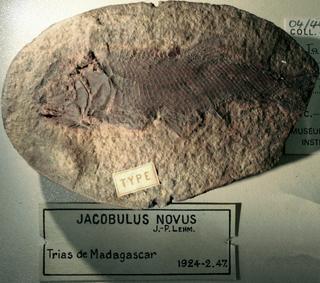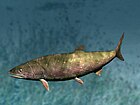
Perleidus is an extinct genus of ray-finned fish from the Triassic period. Fossils have been found in the Middle Triassic of Italy, Switzerland, and China. The inclusion of Early Triassic species in the genus Perleidus was questioned.

Birgeria is a genus of carnivorous marine ray-finned fish from the Triassic period. Birgeria had a global distribution, with fossil known from Madagascar, Spitsbergen, Germany, Switzerland, Italy, Slovenia, China, Russia, Canada and Nevada, United States. The oldest fossils are from Griesbachian aged beds of the Wordie Creek Formation of East Greenland. Birgeria existed throughout the entire Triassic period, from the very beginning just after the Permian-Triassic mass extinction, up to the very end with its extinction during the Triassic-Jurassic mass extinction.
Lehmanotus is an extinct genus of prehistoric bony fish that lived during the Early Triassic epoch in what is now Madagascar. It belongs to Parasemionotidae together with Albertonia, Candelarialepis, Jacobulus, Parasemionotus, Qingshania, Stensioenotus, Suius, Thomasinotus and Watsonulus. It is named after Jean-Pierre Lehman.
Broughia is an extinct genus of marine holostean ray-finned fish that lived during the Induan age of the Early Triassic epoch in what is now Greenland. Fossils were found in the Wordie Creek Formation. A potential concurrent record is also known from Madagascar.

Jacobulus is an extinct genus of prehistoric ray-finned fish that lived during the Early Triassic epoch in what is now northern Madagascar 252.3 to 251.3 million years ago. The type species is Jacobulus novus (monotypy). It was a small fish less than 10 centimetres (3.9 in) in length. J. novus ecology was a grazer-detritivore. It belongs to the Parasemionotidae together with Albertonia, Candelarialepis, Icarealcyon, Lehmanotus, Parasemionotus, Qingshania, Stensioenotus, Suius, Thomasinotus, and Watsonulus.

Australosomus is an extinct genus of prehistoric ray-finned fish that lived during the Early Triassic epoch in what is now Greenland, Kenya, Tanzania, Madagascar, South Africa and Canada.
Helmolepis is an extinct genus of ray-finned fish that lived during the Early Triassic epoch in what is now Greenland, Madagascar and Canada. Species of Helmolepis are small. This genus is closely related with Platysiagum.

Pteronisculus is an extinct genus of prehistoric ray-finned fish that lived during the Early Triassic and Middle Triassic epochs of the Triassic period worldwide.

Parasemionotus is an extinct genus of prehistoric bony fish that lived in the Induan age of the Early Triassic epoch in what is now Madagascar. It is the name giving genus of the family Parasemionotidae and the order Parasemionotiformes.

Paracentrophorus is an extinct genus of prehistoric ray-finned fish that lived during the Induan age of the Early Triassic epoch in what is now Madagascar. The type species is Paracentrophorus madagascariensis (monotypy).

Thomasinotus is an extinct genus of small prehistoric ray-finned fish that lived in the Induan age of the Early Triassic epoch in what is now Madagascar. It belongs to the early neopterygian family Parasemionotidae together with Albertonia, Candelarialepis, Icarealcyon, Jacobulus, Lehmanotus, Parasemionotus, Qingshania, Stensioenotus, Suius, and Watsonulus.

Besania is an extinct genus of prehistoric marine ray-finned fish that lived during the Anisian and Ladinian ages of the Middle Triassic epoch in what is now southern/southeastern Switzerland and northern Italy. Fossils were recovered from the Besano Formation of Monte San Giorgio area and the Prosanto Formation of canton Graubünden, Switzerland.
Scleracanthus is an extinct genus of prehistoric coelacanth lobe-finned fish. It lived during the Early Triassic epoch in what is now Spitsbergen, Svalbard.

Bobasatrania is an extinct genus of prehistoric marine ray-finned fish that survived the Permian-Triassic extinction event. Fossils of Bobasatrania were found in beds of Changhsingian to Ladinian age. It was most speciose during the Early Triassic.

Boreosomus is an extinct genus of Triassic marine ray-finned fish. It was first described from the Arctic island of Spitsbergen, hence its genus name, but was later also discovered in other parts of the world. The type species is Boreosomus arcticus.

Cyranorhis is an extinct genus of prehistoric marine ray-finned fish that lived during the Serpukhovian age of the Carboniferous period. One species is known, C. bergeraci in the Bear Gulch Limestone what is now Montana, United States. It is named after French novelist Cyrano de Bergerac.

Halecomorphi is a taxon of ray-finned bony fish in the clade Neopterygii. The only extant Halecomorph species are the bowfin and eyespot bowfin, but the group contains many extinct species in several families in the order Amiiformes, as well as the extinct orders Ionoscopiformes, Panxianichthyiformes, and Parasemionotiformes. The fossil record of halecomorphs goes back at least to the Early Triassic epoch.

Candelarialepis is an extinct genus of prehistoric marine ray-finned fish that lived during the Induan age of the Early Triassic epoch in what is now Nevada. It contains a single species, C. argentus. It was described from the Candelaria Formation.

Ardoreosomus is an extinct genus of marine ray-finned fish. It was described from the Induan aged Candelaria Formation of Nevada, United States, which was located near the equator during the Early Triassic epoch. It contains only one species, A. occidentalis (monotypy).

Parasemionotiformes is an extinct order of neopterygian ray-finned fish that existed globally during the Triassic period. It comprises the families Parasemionotidae and Promecosominidae. Many of the included genera are monotypic and most species lived during the Early Triassic epoch.



















